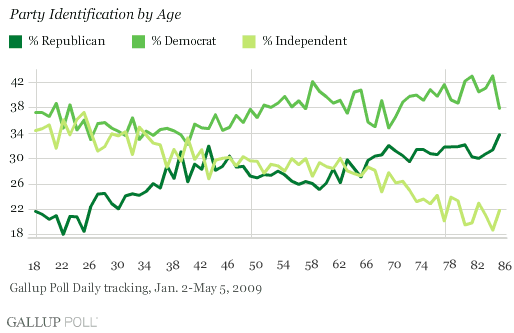PRINCETON, NJ -- Although Democrats currently enjoy a party identification advantage over Republicans among Americans at every age between 18 to 85, the Democrats' greatest advantages come among those in their 20s and baby boomers in their late 40s and 50s. Republicans, on the other hand, come closest to parity with Democrats among Generation Xers in their late 30s and early 40s and among seniors in their late 60s.

These conclusions are based on an analysis of more than 123,000 interviews conducted by Gallup between Jan. 2 and May 5 of this year. This extremely large group of interviews allows for the analysis of party identification for each of the 67 distinct ages between 18 and 85. Gallup conducted interviews with at least 650 respondents at each age, with the average sample size of 1,756 per age year.
As shown in the graph above, there is significant variation in political party identification across the age spectrum in the United States today.
· The percentage of Americans who identify as independents is directly and inversely related to age. More than one-third of the youngest Americans identify as independents, a percentage that drops steadily as the population ages, reaching a low of around 20% among those 80 years of age and older.
· The percentage of Americans who identify as Republicans follows roughly the opposite pattern. Only around 20% of young Americans below the age of 25 identify as Republicans. The percent Republican grows slightly from that point as age increases, up until roughly Americans' mid-40s, and then settles back among baby boomers in their late 40s and 50s. As Americans age into their 60s, the Republican percentage climbs, reaching levels of about 30% and above on average after age 67.
· The percentage of Americans who identify as Democrats follows still a different path. Democrats are quite strong among the youngest Americans, particularly those under age 24, among whom more identify as Democrats than independents. The percent Democrat stays at about the one-third mark until about age 45, when it climbs slightly and remains higher through the 50s and early 60s. From that point on, the percent Democrat hovers around the 40% point, although there is quite a bit of fluctuation from age to age for Americans in their late 60s, 70s, and early 80s.
From a broad perspective, Republicans face a deficit among Americans of all ages. At no single age does the percent Republican exceed the percent Democrat. Still, the range of this Democratic advantage (% Democrat minus % Republican) is quite large, extending from an 18 percentage point Democratic advantage among those 21, 23, and 25, down to just a to 3-point edge among those 39, 43, and 69.

Demographers and social observers have made attempts over the years to classify Americans into generational groups based on the social, political, economic, and cultural environment of the years in which they grew up and "came of age." The most clearly delineated such group is the baby boomers, generally agreed to be those born between 1946 and 1964 -- or roughly ages 45 to 63 today. Generation X follows the baby boom and is generally considered to be those born between 1965 and 1979 -- or roughly between ages 30 and 44. Those younger than Generation X have been labeled Generation Y or the "Millennials," who are 18 to 29 today. There are various ways of grouping those who preceded the baby boom generation, including the famous sobriquet "The Greatest Generation" used by Tom Brokaw in his book of the same name, but it is convenient to label those who today are 64 and older as seniors (even though some in this group would no doubt resist that label).
The current data suggest that political party identification in the United States today follows these generational patterns to a perhaps surprising degree.

· Generation Y (18 to 29) clearly is skewed fairly strongly in the direction of being either independent or Democratic in political orientation. This group constitutes a significant weakness for the Republican Party.
· Generation X (30 to 44) includes some of the strongest support for Republicans. For whatever reasons, the Democratic over Republican gap among Generation Xers, particularly those ages 37 to 43 at the heart of this generation, is on a relative basis much closer to parity than for any other age group with the exception of those in their late 60s.
· Baby Boomers (45 to 63) skew Democratic in their political orientation, with the Democratic advantage reaching a peak at ages 58 and 59.
· Seniors have a more mixed pattern of party identification, with Republicans gaining on a relative basis among those in their late 60s, but with Democrats doing better as Americans age into their 70s and early 80s.
Bottom Line
Democrats have a significant advantage over Republicans today in terms of overall party identification, and the data reviewed here show that this advantage holds at every age between 18 and 85.
At the same time, there are clear ebbs and flows in the degree of this Democratic advantage across the age spectrum. Democrats have the greatest advantage vis a vis Republicans among Americans at the very youngest voting age and also among members of the fabled baby boom, particularly those in their late 50s. Republicans do relatively better among those who are in Generation X, including in particular those in their late 30s and early 40s. Republicans also show greater support among older Americans in their late 60s.
Certainly some of these patterns are typical generational differences. Younger Americans have in the past been more likely to be independents and Democrats regardless of the particular cohort involved.
There is also the hypothesis that the differences are explained by the unique circumstances that surrounded the coming of age of the generations. Baby boomers, as is well known, grew up in the tumultuous age of civil rights, Vietnam, Woodstock, and Watergate. It is certainly possible that these events have marked this generation in a more Democratic or liberal direction for life. Many Generation Xers came of age during the Reagan-Bush years (1980 to 1992) or the "Republican Revolution" marked by the 1994 midterm elections. Today's Generation Y has reached maturity in a time period largely marked by the administration of George W. Bush, and certainly for many the nascent Obama administration is a major formative factor in their political orientation.
Survey Methods
Results are based on telephone interviews with 123,890 national adults, aged 18 and older, conducted Jan. 2 to May 5, 2009, as part of Gallup Poll Daily tracking. For results based on the total sample of national adults, one can say with 95% confidence that the maximum margin of sampling error is less than ±1 percentage points. The maximum margin of sampling error for each individual age varies depending on sample size, ranging from +/- 2% to 4% for any individual age.
Interviews are conducted with respondents on land-line telephones (for respondents with a land-line telephone) and cellular phones (for respondents who are cell-phone only).
In addition to sampling error, question wording and practical difficulties in conducting surveys can introduce error or bias into the findings of public opinion polls.